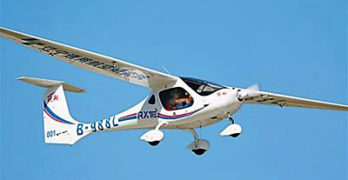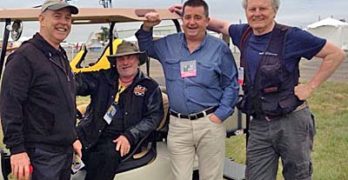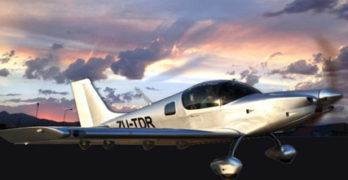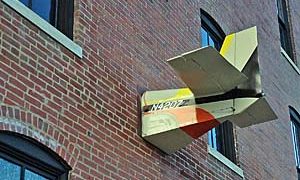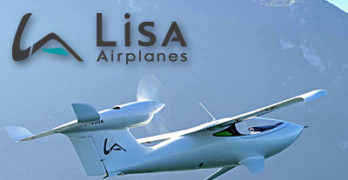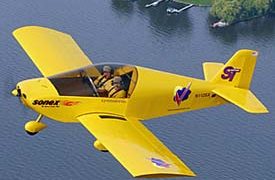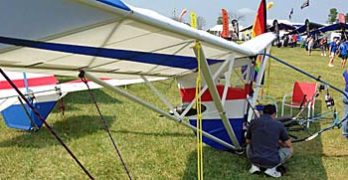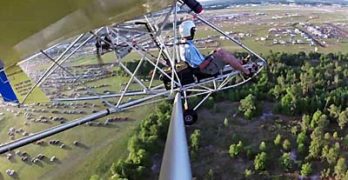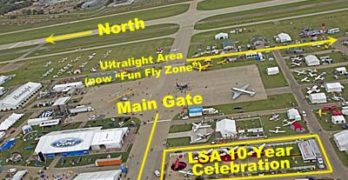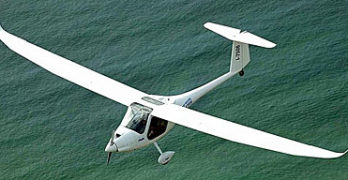All over the world, electric airplanes are getting remarkable amounts of attention, deservedly so as an exciting development to match work in cars and other vehicles. These days, while drones (also called UAVs, UASs, or RPVs) are made in various countries, a lot of the development comes from China … so why be surprised to hear of a positive development in a Chinese human-occupied aircraft?
Is it the first “certified” electric? Well, “certified” is a term that can be challenging to define as the word means different things in different countries. For example, we’ve already produced a video covering the American-designed, Chinese-developed eSpyder from Yuneec. It won German approval in 2013. My flying experience on eSpyder is documented in this article. You can also read a more encompassing electric aircraft review article from 2011, though with the rapid pace of development such articles become dated rather quickly.
Search Results for : motorglider
Not finding exactly what you expected? Try our advanced search option.
Select a manufacturer to go straight to all our content about that manufacturer.
Select an aircraft model to go straight to all our content about that model.
Boeing & Airbus Explore Light Aircraft
Recently I had a visit from my longtime friend and fellow aviation journalist, James Lawrence (photo). Among other mutual interests we share a passion for electric aircraft. We’ve each flown early examples and believe we see the future. From the headline above, you might interpret that to mean we anticipate electric airliners. We might … yet we recognize such developments remain distant. Or, do they?
The electric power action today is in very light aircraft — and some are available for you to buy and fly immediately. One example is Zigolo and I’ve reported on eSpyder. The reason is that light aircraft rule is singular: batteries, which weigh too much to allow heavier aircraft any range. The ending video explains why.
Unless you’ve been off-planet for a while, you know the development of improved battery technology is drawing many billions of dollars of investment. Cars, laptops, drones and many more products or industries want better batteries.
LSA Taildraggers Broaden the Sector’s Appeal
Taildraggers may be among the least understood and most feared aircraft available in the LSA space … or for that matter throughout general aviation. While we have many good choices that I’ll list below, I have nonetheless heard from many readers or airshow visitors that they are uncertain about their operation of an aircraft that has no nosewheel. If you have no taildragger skills, you’ll also find it a challenge to get proper flight instruction in a “standard” aircraft. For those seeking new skills in flying, however, taildraggers may provide high satisfaction. Most who have crossed the barrier to taildragging subsequently look very fondly at such aircraft, seeing a sleeker yet gutsier, more rugged appearance. Of course, nosewheels dominate general aviation as they can be easier to land, especially in crosswinds, but once you learn the lesson of “happy feet” — or keeping your feet active on the rudder pedals throughout approach and touchdown — you may always yearn for more taildragger time.
Midwest LSA Expo 2014 Highlights
The sixth annual Midwest LSA Expo just concluded. These LSA-only events offer a more intimate setting where you can speak at length with an aircraft or other product representative. They don’t offer the dense traffic of the big shows but the valued trade off is that nearly everyone who shows is interested. People came from as far as California and I witnessed many demo flights. The Mt. Vernon airport is as good as it gets for this purpose with easy access to big broad runways and plenty of open airspace. Lead by energetic Chris Collins, a team of volunteers made it work again. When the event isn’t swallowing all their time these folks have a little fun. Don’t worry about the nearby picture; TSA and Homeland Security can calm down. This was a planned promotional venture on the side of a great new restaurant called Rare, a chop house.
Amazing LSA Seaplanes: Lisa’s Supersleek Akoya
We just passed September 1st and that date is significant in the LSA universe. It is the day, ten years ago, that the Sport Pilot & Light-Sport Aircraft rule we have been celebrating all summer officially became part of the Federal Aviation Regulations (FARs). If you’re thinking, “Hey, I thought it was announced in the summertime, at AirVenture!” … you’re correct. It was, but that was just the administrator’s public relations timing to get the biggest bang for the buck, at Oshkosh. As we continue the tenth anniversary celebration — looking back on the first decade — we see the astounding development of 136 models of LSA, more than one every month for ten years running. This profusion of models runs the length and breadth of aviation, from fixed wing, three axis airplanes to powered parachutes to trikes to motorgliders and from less than $30,000 to over $200,000. I fully expect designers to continue pushing the envelope in every direction but one facet of LSA development seems as energized as a Saturn V moon rocket: LSA seaplanes.
Sonex Roars, Purrs, & Glides; Factory-Built Van’s
Two key members of AKIA stopped by the LSA Mall at the new & improved Paradise City last week. AKIA? The Aircraft Kit Industry Association is a new group formed in July last year seeking cooperation between kit aircraft builders. Leaders include Van’s Aircraft and Sonex. Both have been making Light-Sport models, or what more correctly might be called “Sport Pilot eligible” or “Light-Sport-compliant aircraft.” Experimental Amateur Built (EAB) aircraft are technically not LSA even if they meet all parameters. Sonex and Van’s are upstanding producers of very popular aircraft and they have their eyes clearly on the light aircraft sector that is showing great resilience in a perpetually sluggish economy. Each company has too much info to fully cover here but a birds-eye view may encourage you to seek more.
Sonex Aircraft is based in Oshkosh, Wisconsin, right across the field from EAA’s headquarters. The company is so active on so many fronts that I will only provide a general view.
Affordable EMG … Electric Motor Glider
Update 8/8/14 — See our video interview about EMG at the end. An unpowered EMG — or Electric Motor Glider — from Adventure Aircraft has already taken 400 flights; it has also been fitted with a small electric motor … complete with carbon folding prop. A new Experimental Amateur Built (EAB) two seater is now taking shape and both variations were on exhibit at AirVenture 2014 in the newly named Fun Fly Zone (formerly Ultralight Area). EMG’s spark is provided by the dynamic duo of Brian and Carol Carpenter of Rainbow Aviation, well known for their LSA maintenance courses including the LSR-M (Light-Sport Repairman Maintenance) credential that has prepared many mechanics to do serious work on the growing fleet of LSA. EMG builder Adventure Aircraft is a subsidiary of Rainbow. Evidently this hard working pair aren’t fond of wasting many hours with something so mundane as sleep because the project is unfolding quite swiftly.
Zigolo Cracks the China Market as Part 103!
I didn’t see this one coming. Maybe you didn’t either? In the new millennia gold rush represented by companies either being bought by Chinese businesses or gaining investment from wealthy Chinese business people or by setting up shop to sell in China (or even Cessna’s ill-fated effort to have their Skycatcher manufactured in China), one element I’ve never heard of is Part 103 in China. This least-regulated-of-all aviation category is solely an American thing, isn’t it? Well … yes and no. Germany has opened the door to a Part 103-like development in that country under the 120-kilogram class (using a number that is 264 pounds or very similar to Part 103’s 254-pound empty weight limit). England has their SSDR class (SSDR being the abbreviation for Single Seat De-Regulated). Despite following those developments, I’ve never heard a word about China and any less-regulated sector.
“The first Zigolo in China was introduced to the public in that nation on July 17th at the Jingmen Airshow,” reported representative Chip W.
Happy Birthday Sport Pilot / Light-Sport Aircraft!
Some may find it hard to believe that ten years have passed since FAA made its grand announcement introducing the Sport Pilot / Light-Sport Aircraft regulation. Others may see it differently. Some thought the rule was a long while coming. A number of people gave of their time to an ARAC (Aviation Rulemaking Advisory Committee) that deliberated for more than ten years prior to the 2004 announcement. What started out as a means to expand ultralight aircraft and to “fix” certain problems that had arisen ended up doing something completely different … although some in the agency maintain they did fix the “fat,” or two seat “ultralight problem.” Many insiders didn’t feel the problem got solved so much as got buried under other initiatives, but that’s a story for another article. What did emanate from the ARAC work and FAA’s lengthy internal deliberations was a game-changing method of approving aircraft and I, for one, salute the agency for its brave achievement.
2013 Light-Sport Market Share Report & Analysis
UPDATE: May 27, 2014 — “A vigorous debate ensued …” might be one way to refer to a four-way discussion from around the globe. Over the last few days, LSA industry folks in distant lands worked on market share details. Michael Coates is the Australian-based U.S. distributor for Pipistrel, an aircraft fabricated in Slovenia and assembled as a LSA in nearby Italy for shipment to the USA. My Czech-based associate, Jan Fridrich, was in China again because his country works with that nation as they build a personal aviation sector virtually from scratch. From our corners of the world we tried to resolve a problem that regularly occurs in our study of the FAA registration database. Pipistrel maintained their SLSA airplane numbers were stronger. Jan and I communicated and finally agreed that we were underreporting their numbers. The chart below has been modified to reflect a truer situation, sharply moving Pipistrel upward from 20th to 14th rank.
- « Previous Page
- 1
- …
- 9
- 10
- 11
- 12
- 13
- …
- 23
- Next Page »


